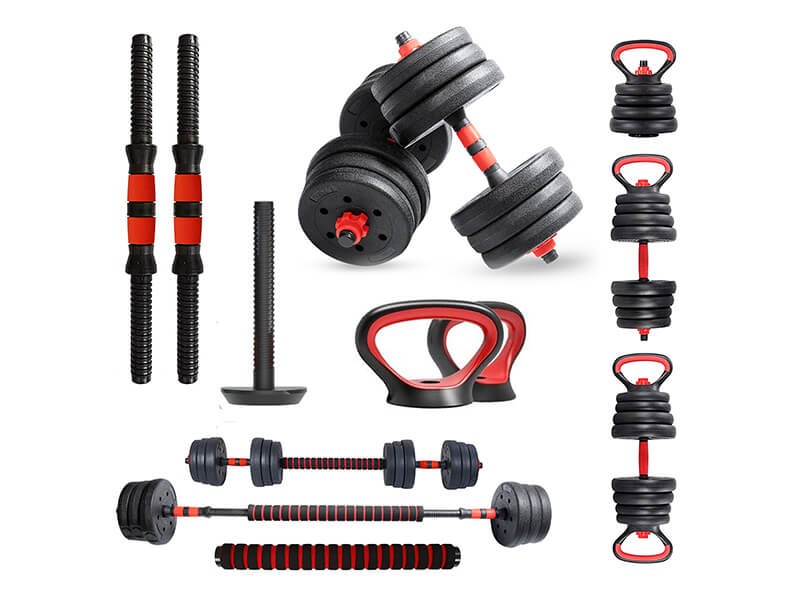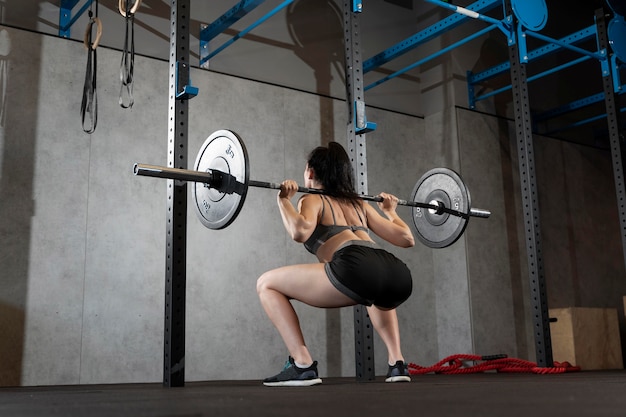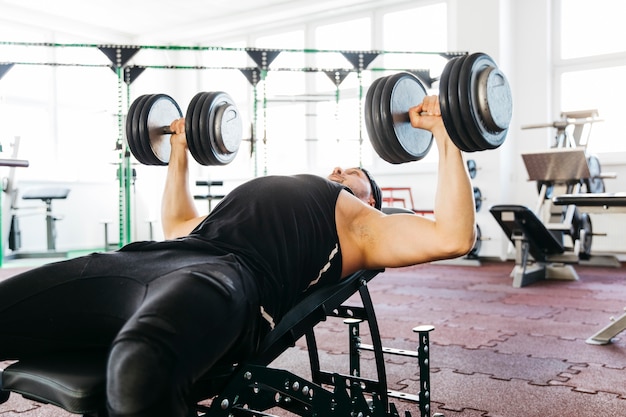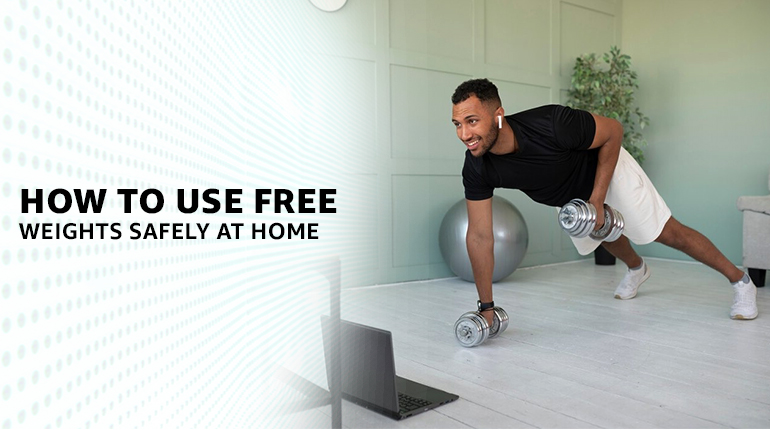Free weights are strength training fitness equipment (such as dumbbells, barbells, and kettlebells) are essential tools for anyone looking to build strength, and muscle, and improve overall fitness. They are versatile exercise equipment and offer effective way to work out, but they also come with certain risks if not used correctly. In this blog, we'll explore how to safely use free weights in your home gym, ensuring you get the most out of your workouts while minimizing the risk of injury.
What are Free Weights?
Essentially, free weights are any weights that are not attached to a static exercise machine. This includes:
-
Dumbbells: Dumbbells are small, handheld weights that are great for a variety of exercises. They can further be classified into hexagon rubber dumbbells. Rounded dumbbells, selectorized dumbbells, and more.
-
Barbells: Barbells are long bars with weights attached to either end. They’re commonly used for lifting heavier weights. 
-
Kettlebells: Kettlebells are weights with a handle, often used for dynamic movements such as presses, push-ups, pull-ups, lunges, squats as well as deadlifts.
-
Weight Plates: Weight plates are discs that can be added to barbells or even used independently.
Unlike machines, which guide your movements, free weights serve a different purpose. This means they require you to use stabilizing muscles to control the weight. This contrast makes them highly effective for building functional strength but also means there's a higher potential for injury if not used correctly.
Setting Up Your Home Gym
A safe and effective workout begins with a well-organized home gym. Here's how to go about with it:
-
Adequate Space: Ensure you have enough room to move freely around your weights. This helps prevent accidents and allows for a full range of motion in your exercises.
-
Sturdy Flooring: Use a non-slip, cushioned surface to protect your floors and provide a stable base for lifting.
-
Proper Storage: Keep your weights organized and off the floor when not in use. This reduces the risk of tripping and makes it easier to find the weights you need.
Upgrade your home gym with high-quality free weights? Check out the selection of free weights at PowerMax - the best fitness equipment brand in India, and start your fitness journey today!
Learning Proper Form
Proper form is crucial when lifting weights. Injuries can result from improper form, particularly while heavy lifting. Here are some important things to think about:
-
Start Light: Begin with lighter weights to learn the movements before progressing to heavier weights. Begin with lighter weights to learn the movements before progressing to heavier weights. Start with 2-5 kg dumbbells for upper body exercises like bicep curls, shoulder presses, and tricep extensions. For exercises like bench presses, squats, and deadlifts, starting with just the barbells around is a good idea. Increase the weight range as you become more comfortable with the movements. This helps you focus on technique without overloading your muscles.
-
Use Mirrors: If possible, set up mirrors in your home gym to check your form. This visual feedback can help you correct any mistakes.
-
Educate Yourself: Use resources such as instructional videos, books, or even hire a personal trainer to learn proper form. Understanding the mechanics of each exercise is essential.
Warm-Up and Cool-Down
Warming up and cooling down are often overlooked but are vital for preventing injuries and improving performance.
-
Warm-Up: Spend 5-10 minutes doing light cardio (such as jogging or jumping jacks) and dynamic stretches to increase blood flow to your muscles and prepare your body for lifting.
-
Cool-Down: After your workout, spend another 5-10 minutes doing static stretches to help your muscles relax and recover.
Safety Tips for Lifting
When you're ready to start lifting, keep these safety tips in mind:
-
Use a Spotter: If you're lifting heavy weights, especially with exercises like the bench press or squat, use a spotter to help you if you get stuck.
-
Control the Weight: Avoid using momentum to lift weights. Instead, lift and lower the weight in a controlled manner to engage your muscles fully and reduce the risk of injury.
-
Breathe Properly: Exhale during the exertion phase (when lifting or pushing) and inhale during the lowering phase. Proper breathing helps maintain stability and can prevent dizziness.
-
Avoid Overtraining: Give your muscles time to recover by incorporating rest days into your routine. Overtraining can lead to fatigue and increase the risk of injury.
-
Know Your Limits: Don’t attempt to lift more weight than you can handle. You can increase the weight as you feel yourself get stronger.
Common Free Weight Exercises and How to Perform Them Safely
1. Dumbbell Bicep Curl
-
Starting Position: Stand with feet shoulder-width apart, holding a dumbbell in each hand, arms fully extended.
-
Movement: Curl the dumbbells up towards your shoulders, keeping your elbows close to your body.
-
Safety Tip: Avoid swinging your body or using momentum. Focus on controlled movements and fully extend your arms back to the starting position.
2. Barbell Squat

-
Starting Position: Stand with feet shoulder-width apart, barbell resting on your upper back.
-
Movement: Lower your body into a squat position, keeping your back straight and knees behind your toes.
-
Safety Tip: Use a squat rack for safety, and don’t go too deep into the squat until you’re comfortable with the form.
3. Kettlebell Swing
-
Starting Position: Stand with your feet shoulder-width apart and hold the kettlebell with both hands.
-
Movement: Swing the kettlebell between your legs and then forward up to shoulder height.
-
Safety Tip: Use your hips to generate power, not your arms. Keep your back straight and avoid hyperextending your lower back.
4. Bench Press

-
Starting Position: Lie on a bench with your feet flat on the floor, holding a barbell with hands slightly wider than shoulder-width apart.
-
Movement: Lower the barbell to your chest, then push it back up to the starting position.
-
Safety Tip: Always use a spotter or safety bars in a power rack. Don’t bounce the bar off your chest.
5. Deadlift
-
Starting Position: Stand with feet hip-width apart, barbell on the floor in front of you.
-
Movement: Bend at your hips and knees to grab the barbell, then lift it by straightening your hips and knees.
-
Safety Tip: Keep the bar close to your body, back straight, and lift with your legs, not your back.
Also Read: Achieving Full-Body Workouts at Home with Multi-Gyms
Enhance your workouts with premium free weights from PowerMax - the best fitness equipment brand in India. Explore our range of dumbbells, barbells, and kettlebells today!
Listening to Your Body
Pay attention to how your body feels during and after workouts. Pain is a signal that something might be wrong. If you experience sharp or sudden pain, stop the exercise immediately. More importamtly, be sure to modify exercises that cause discomfort. There are often multiple ways to work the same muscle group. Finally, allow time for your muscles to recover, especially if you’re new to weightlifting.
Conclusion
Using free weights in your home gym can be a highly effective way to improve your strength and fitness, but safety should always come first. By setting up your gym correctly, learning proper form, and following safety tips, you can enjoy the benefits of weightlifting while minimizing the risk of injury. Remember, fitness is a journey, and staying safe ensures you can keep progressing without setbacks.
 India (INR)
India (INR)
 UAE (AED)
UAE (AED)
 Store Locator
Store Locator






-thumb.jpg)
-thumb.jpg)
-thumb.jpg)
-thumb.jpg)
-thumb.jpg)
-thumb.jpg)
-thumb.jpg)
-thumb.jpg)
-thumb.jpg)
-thumb.jpg)